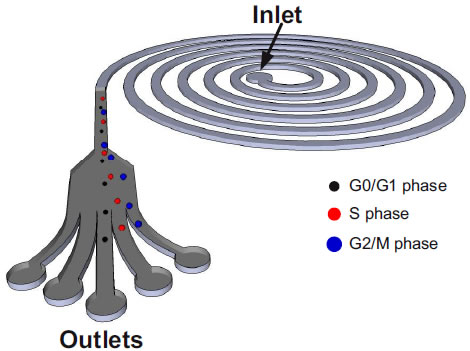|
Singapore-MIT Alliance for Research & Technology |
BioSystems and Micromechanics (BioSyM) Inter-Disciplinary Research Group |
||||
Cell Cycle Synchronization of Stem Cells Using Inertial
|
|||||
 |
Schematic illustration of the spiral microfluidic design developed for cell cycle synchronization. Under the
influence of inertial lift forces and Dean drag force, the hMSCs are size fractionated to obtain relatively pure populations of cells in the G0/G1, S and G2/M phase. The cells in the G2/M phase, due to the large size, equilibrate closest to the microchannel inner wall followed by cells in the S and G0/G1 phase. |
|---|

A. Photograph of the spiral microchannel with one inlet and eight outlets fabricated in PDMS. B. Optical micrographs
of the size sorted cells collected from outlets 2, 3 and 4. bar = 50μm. C. Viability of sorted hMSCs verified using trypan
blue exclusion assay. Results indicate that the shear experienced at very high flow rates (2 mL/min), do not compromise
the cells achieving >90% cell recovery.
For details, see CELL CYCLE SYNCHRONIZATION OF STEM CELLS USING INERTIAL MICROFLUIDICS, Wong Cheng Lee, Ali Asgar. S. Bhagat, Sha Huang, Krystyn J. Van Vliet, Jongyoon Han, Chwee Teck Lim, in Proceedings of MicroTAS-2010, pp. 208-210

